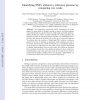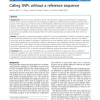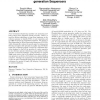SPIRE
2010
Springer
14 years 1 months ago
2010
Springer
Next generation sequencing (NGS) technologies are being applied to many fields of biology, notably to survey the polymorphism across individuals of a species. However, while single...
FPL
2010
Springer
14 years 1 months ago
2010
Springer
We demonstrate how Field Programmable Gate Arrays (FPGAs) may be used to address the computing challenges associated with assembling genome sequences from recent ultra-high-through...
BMCBI
2008
14 years 3 months ago
2008
Background: At intermediate stages of genome assembly projects, when a number of contigs have been generated and their validity needs to be verified, it is desirable to align thes...
BMCBI
2010
14 years 3 months ago
2010
Background: The most common application for the next-generation sequencing technologies is resequencing, where short reads from the genome of an individual are aligned to a refere...
SAC
2010
ACM
14 years 3 months ago
2010
ACM
Next Generation Sequencing machines are generating millions of short DNA sequences (reads) everyday. There is a need for efficient algorithms to map these sequences to the referen...



